―Story and Photos by Charlene Strickland
A course set at 1 meter (3ft 3in) is a milestone for a young or green jumper, but it’s moving up to 1.20m that the horse shows his talent. Adding 8 inches—with spreads, combinations, and distances—poses greater questions for the horse and rider to answer. How confident is the horse? Does he show the scope to clear height and width? Is he rideable in turns and adjustable at each fence, both in the approach and after landing? If he’s clear, is he poised and fast in a jump-off? We talked with jumper riders about young horses to see how they evaluate contenders at 1.20m courses.
Bred to Excel
Bloodlines can predict jumping ability. Rainland Flurry (Flexible x Calvaro Z) is a 2013 mare, bred by Robert Fleck, DVM of Woodinville, Washington. With Rich Fellers, Flexible won the 2012 FEI World Cup Finals and placed 8th at the 2012 Olympic Games. Also an exceptional jumper, Calvaro Z ranked 17th on the 2019 list of Show Jumping Sires (World Breeding Federation for Sport Horses).
In 2019, Flurry was champion of the Thunderbird Show Park Series—Crooks Show Jumping 6-Year-Olds. At those shows in Langley, B.C., she earned the nickname Flurrious. “Fast and flurrious. She has a little fan club already,” said her rider, Audra Fleck-Snijders, Dr. Fleck’s daughter. Audra continued, “She’s not big but she has a huge heart. She’s my very good friend. She is one of the smartest horses I’ve ever had. She is fast and careful.”

Audra also noted that Flurry inherited swiftness from Thoroughbred ancestors. “I rode her mother, who has a lot of Thoroughbred on her side,” she said. “That gives her speed.” Dr. Fleck said, “I’ve never seen her have a time fault. We knew she was special early on. At 2 1/2 and 3 years, she was jumping over little things.” He added, “I think this is one of Flexible’s best babies. Rich [Fellers] thinks that. We call her the mini Brute. Flexible is not real big. You’re surprised that he jumped meter-60.” Flurry stands only 15.3hh.
In 2020, Fleck-Snijders rode Flurry to be the Circuit Champion of the 7-year-old young jumper division in the Desert Circuit at Desert International Horse Park in Thermal, California.
Derek Braun, of Split Rock Farm in Lexington, Kentucky, talked about Colour Your Day (Contendro I x Landadel), who’s now 11. He showed the Holsteiner in USEF six-year-old classes and developed the horse’s talent through the levels. Derek explained how a horse can show what jumper division suits him: “You feel what those instincts are in the horse that can move to the next level.” The rider needs to have the knowledge to nurture a prospect, and then see what level matches the horse’s talents.

Is the horse careful? Does he have the scope and the attitude to move beyond the meter courses? “I try to search for real quality as a young horse and then take the time to produce them up the ranks,” said Derek, who explained that the horse’s attitude affects how he jumps, whether at a lower level or the Grand Prix. Many horses can jump the same way they do at meter-20 as they do at meter-60, but it’s the horse’s desire that makes him a candidate to progress, ultimately to the Grand Prix. “Riders can really sense what the horse is telling them.”
Developing Talent
Kirsten Coe of Johnston, South Carolina has represented the US internationally and competed in the FEI World Cup Jumping Final, earning her over $1M in prize money so far. Kirsten trains and shows young horses bred by her family’s Equine Trading Company, Inc. She explained how she lets a young horse progress at his own speed, aiming for the horse to feel comfortable on course. “I might push them up one division and go back down, and then go up again and go back down until I feel like they’re comfortable jumping all the heights and the different elements—the Liverpools, doubles, triples.”
Kirsten does not ask too much of a youngster. “I let them tell me what they’re ready for. The five-year-olds do pretty basic work… very small jumps. We don’t start pushing them until the middle of their six-year-old year. Then, we start asking them for a little bit more. We keep on going with that process, which has seemed to work for us.” Another technique of Kirsten’s is to use each competitive round as a training assignment. “Every time we’re teaching them something. Every class we do, we work on a specific thing, whether it’s rideability, turns, or an element in the course. Every round has a specific purpose.”
Lauren Hester of Hester Equestrian in Lexington, Kentucky also trains and competes young horses. Lauren has earned over $1M prize money in her career as well. Her newest up-and-coming star is Happy Feet B (Zacherov x Canturano I). She bought the 2012 mare at the foal auction organized by Stal Hendrix in Limburg, the Netherlands. She admits picking the gray foal for her name. “It was my first time buying a foal. It worked out.”

Lauren won with the KWPN mare in five-, six-, and seven-year-old classes. “Happy was very special from the beginning. They broke her over there [in the Netherlands] and told me about how special she was. She is my first horse that I bought as a foal or even brought along, so I was very excited. She was special when she was a four-year-old and she was third in the five-year-old finals in Kentucky. She had the fastest time in the jump-off, but I made a mistake and caused her to have the last jump down.”
A good win in 2020 was the FEI Ruby Speed 1.35m class at the Desert Circuit. “She has her ups and downs,” said Lauren. “Last year she moved up to the meter-40 Grands Prix. She was second in her first Grand Prix and then she won her second Grand Prix! We did two more Grand Prix classes at the World Equestrian Center where she was also first and second. I gave her a break, and now we’re bringing her back up again. I gave her a break because she’s young.”
Analyzing Performance
The horse tells the rider about his comfort and confidence, and the rider can help the horse improve on course. Riding can affect the horse’s style, adjustability, and speed. An example is another mare, Midnight Hour, foaled in 2013 from KWPN parents. Her sire, Wamberto, was champion at the 2006 KWPN Stallion Show and also won the 2007 U.S. 100-day Stallion Performance Test.
Midnight Hour was originally aimed at dressage. Trainer Stephanie Gershon of Skybound Farm in Santa Fe, New Mexico found that the mare showed talent over cross rails. “She was slow to mature, and then all of a sudden she started to show some athleticism with her jumping. She was jumping high because she was so careful. That’s one of the challenges in bringing her along,” explained Stephanie. “She was at the tops of the standards when I did the five-year-old classes.”

As jumps became higher, Midnight Hour had to adjust her style. “Up to meter-30 has been ground-breaking for her. It’s starting to click for her. Her go-to was to jump higher. Now she is better with her knees. She has a good hind end. She’s starting to get much more clever about jumping.” Stephanie rides with Everardo Hegewich in California, “Everardo says not to move up to the next level until the horse is perfect at one level.”
Kirsten Coe aims to have a horse learn the size and the technical aspects of a course. An athletic jumper may need to focus on increasing rideability, such as responding on turns. She said, “Whenever I feel they are struggling with an issue, whether it’s something on the course or rideability or a related distance, whenever they get too careful—maybe you have to assess what’s going on in the round and with the horse. That’s when you would drop back down and make them comfortable.”
A horse can become aggressive on course, running at the jumps. For such a horse, Kirsten said, “They have to learn patience. Every horse is an individual, and they need to learn their individual weaknesses and strengths.” She recommends a positive attitude: “In the end, for a horse, confidence is king. If you can always nurture that feeling for them, then they can excel.”
Lauren Hester’s Happy Feet B is an example of such learning. Lauren said that the Dutch horsemen cautioned her. “They did warn me that even though she was very talented, she was very difficult. I found that out early on when she wouldn’t accept injections or let us even cut her mane with scissors. Her attitude continued to worsen, and she wouldn’t go in the ring or let me do any flatwork with her.”
When Happy was seven, Lauren hired California trainer Allen Clarke to alter Happy’s outlook. “He got her going in the ring and almost riding like a normal horse. She is a sweetheart in the barn, but as soon as you try to do flatwork she still gives you a run for your money. I think that’s what makes her such a good horse is because she fights for what she wants.”
USEF Rules
The USEF Rulebook, JP124, describes the course for the 1.20m division. The minimum speed is 350 meters per minute (roughly 15 miles per hour), over a course of at least 10 jumping efforts, of which three of the first eight must be spreads (oxers). Rule JP116 has the standards for young horse competitions, at five, six, and seven years old. These classes invite youngsters to gain confidence and excel. Fence heights are 1 meter to 1.15m (five-year-olds), 1.20m to 1.25m (six-year-olds) and 1.30m to 1.35m (seven-year-olds). Heights can increase after July 1 of the show season.
Interested in more Hunter/Jumper stories? Go here.
Want to know more about the USEF Hunter/Jumper rules? Read the USEF Rulebook.
From Bosque Farms, New Mexico, Charlene is an equestrian journalist, writing about sport horse training, showing, and breeding. She’s earned awards for her magazine work from the US Equestrian Federation, The Chronicle of the Horse, and the Society for Technical Communication. In 2013, she won the Alltech A+ Award for Best Article. She is a member of the International Alli-ance of Equestrian Journalists. Charlene has ridden and shown Western, hunters, and dressage.





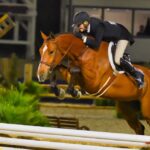
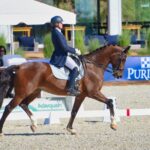


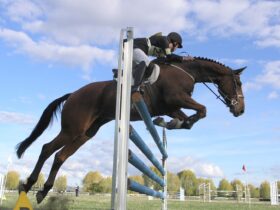





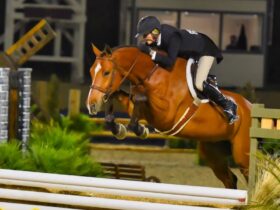


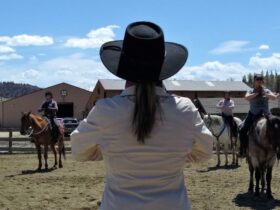


SOCIAL